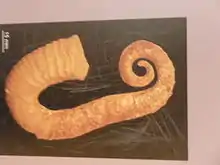Ancyloceras
Ancyloceras is an extinct genus of heteromorph ammonites found throughout the world during the Lower Cretaceous, from the Lower Barremian epoch until the genus extinction during the Lower Aptian.[1][2][3]
| Ancyloceras | |
|---|---|
 | |
| Ancyloceras | |
| Scientific classification | |
| Kingdom: | |
| Phylum: | |
| Class: | |
| Subclass: | |
| Order: | |
| Family: | |
| Genus: | Ancyloceras d'Orbigny, 1842 |
| |
Selected species
- A. audouli Astier, 1851
- A. fallauxi Uhlig, 1883
- A. mantelli Casey, 1960
- A. matheronianum d'Orbigny, 1842
- A. vandenheckii Astier, 1851[1]
Description
Ancyloceras ammonites have a shell reaching a length of about 10 centimetres (3.9 in) and a width of about 7 centimetres (2.8 in). They are known as heteromorph shaped, with a partly uncoiled shell and the aperture directed toward the coiled part.
Most ammonites are homomorph, as they maintain the same shape throughout the growth, while the ammonites in this genus have uncoiled shells (heteromorph or different-shaped ammonites), that would have precluded fast swimming.[1]
Distribution
Fossils of Ancyloceras species are found in the Cretaceous Barremian Stage (117-113 million year old) marine strata of Europe and Morocco.
References
- David L. Clark Anisoceras and Ancyloceras from the Texas Cretaceous Journal of Paleontology - Vol. 32, No. 6 (Nov., 1958), pp. 1076-1081